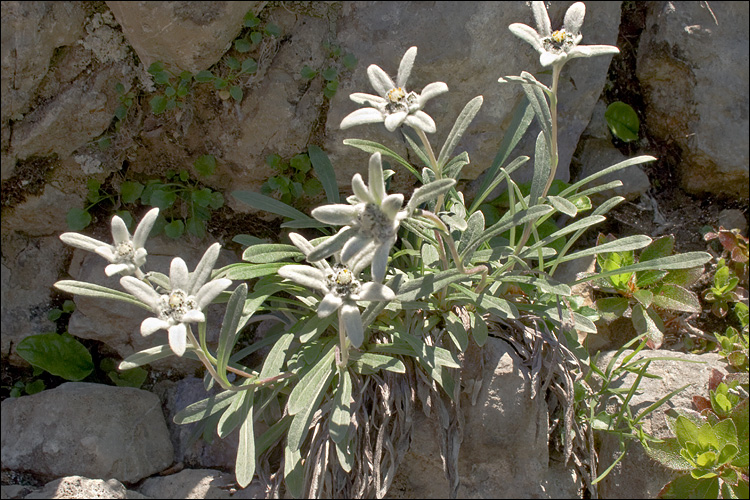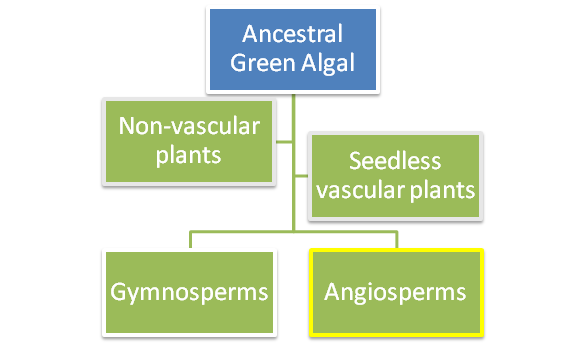Classification
Domain:
Eukarya
Kingdom: Plantae
Phylum: Magnoliophyta
Class: Magnoliopsida
Order: Asterales
Family: Asteraceae
(Compositae)
Genus: Leontopodium
Species: Leontopodium alpinum

Leontopodium alpinum translates rougly from Latin into
modern English as "lion's foot" because it resembles the
hairyness of a lion and its claw. The common name of Edelweiss
stems from the German word edel, meaning nobility, and
weiss, representing the color white (Fun Trivia 2014).
The Missouri Botanical Garden has well-written entry devoted to
Edelweiss that you can find
here and another website, located
here, displays photographs and information about Edelweiss
and several close relatives that are often mistakenly refered to
as Edelweiss.
Eukarya:
The domain
Eukarya represents every organism that contains membrane-bound
organelles and at least one nucleus per cell. These cells that have
conveniently taken the name eukaryotic cells. Organisms under this
category can take on unicellularity (such as
Brewer's Yeast), colonial
living relations (some protists) or multicellularity (most animals
and fungi). Cells of this type most often undergo mitosis for
growing purposes but can also utilize meiosis to produce
reproductive cells called gametes. Eukaryotic cells are believed to
have formed from prokaryotic (no nucleus or membranous organelles)
cells through endosymbiosis. This process theorizes that smaller
prokaryotes such as cyanobacteria took residence in larger ones for
a mutalistic benefit to both organisms, and this relationship
eventually led to the development of the mitochondria and other
organelles that have evolved over time to the point where today they
would not be able to live outside of the cell on their own.
The kingdom Plantae identifies, in a broad sense, organisms with cell walls made of cellulose that photosynthesize as a means to collect food. There is much variety in the Plantae kingdom: encompassing a terrestrial (Prickly Pear Cactus) or aquatic (Wild Rice) habitat, the means of reproduction, and what type of chloroplast is used to collect food via photosynthesis. All plants have a type of leaf that collects sunlight, but some can develop more complex organ systems that include stems and leaves, and even others are capable of woody (outward) growth. Plants can be divided into the following major clades: Hepaticophyta, Bryophyta, Lycophyta, and Anthophyta (Gymnosperms and Angiosperms). Plants are multicellular organisms that grow through mitosis and can reproduce both asexually or sexually. Plants are one of the only organisms that can photosynthesize and are thus the food source for many other organisms that are heterotrophs.

This phylogenetic tree shows the evolution of the land plants. A
green algal component is believed to be the ancestral organism that
land plants evolved from. This tree displays all non-vascular and
seedless vascular plants as their own distinct groups and then
groups the sister taxa
of the vascular seed plants: Gymnosperms and Angiosperms.
Angiosperms, as identified below, are part of Leontopodium
alpinum's scientific classification. This information was taken
from lecture notes and materials.
Magnoliophyta
is a division that includes flowering plants (Angiosperms). Plants
within this category have the three main organ systems of plants:
root, stem, and leaves, and include the
Highbush Blueberry and
apple. They also have vascular systems, such as the
xylem (water and nutrient up) and phloem (food and nutrients down).
Angiosperms have specialized cells to carry out specific needs of
the plant, and this contributes to the effectiveness of growth. The
seeds these plants produce are covered and encased within a
shell-like structure. This is optimal for both protective purposes
and the seed’s ability to thus remain dormant until it can be
germinated properly and in a positive environment. In terms of
pollen, pollen grains typically germinate the plant through the
stigma, which is connected to the ovary. Angiosperms are one of the
most thoroughly studied groups of plants today.
Members of the magnoliopsida class are generally referred to as dicots—the seeds have two developing leaves. There is much diversity within the dicotyledonous class; about half of the species are capable of secondary growth (UW-Madison, Department of Botany). The flower portion of the plant is often arranged in a circular pattern, with four or five petals. Dicots typically have a taproot system and the leaves are heavily vascular. Scientists often agree that the dicotyledon class can be categorized into six subclasses: Magnoliidae, Hamamalidae, Caryophillidae, Dilleniidae, Rosidae, and Asteridae (The Free Dictionary 2012). Members of this class apart from Edelweiss include Dragonfruit, lemons, and kiwifruit.

A
The order Asterales can be classified
based on several characteristics that connect the larger families of
Asteraceae and Campanulaceae to the significantly smaller families
of Goodeniacae, Stylidiaceae, Menyanthaceae, Calyceraceae,
Rousseaceae, Pentaphragmataceae, Alseuosmicaceae, Phellinaceae, and
Argophyllaceae (Paul E. Berry 2014). They have universal chemical
similarities including inulin (a particle used for storage) and can
also be linked because of their pollination anatomy. Plants of this
group can store pollen on the pistil on the flower, giving the term
“plunger pollination” because of the mechanisms involved in uniting
the pollen and the ovary.
The Asteraceae family is known collectively as the “sunflower” family, and it is one of the biggest plant families as of current research. Inflorescence is a common feature in this family, where many small flowers (florets) are clustered together, and in some cases, it appears as though the mass of flowers is merely one single flower (Encyclopaedia Britannica 2014).The flowers are surrounded by bracts, which are a structural element that resembles a leaf. The older name for this family is Compositae because of the composite flowers on each plant, and is still a valid term in classification. Examples of others from this family include the Purple Cone Flower and Globe Artichoke, and, of course, the Sunflower.
There are less than forty known members
of this genus, most commonly located in Europe and Asia. In some
cases, other organisms within this genus are mistakenly called
Edelweiss because of the popularity of Leontopodium alpinum
in Austria and pop culture, but it is important to recognize
that only one species bears this name. Leontopodium
translates to mean “lion’s foot,” and can be associated with the
physical features of the plants in this genus, which, in fact,
resemble the clawed foot of a lion.
This is the scientific name for Edelweiss, an alpine flower native to Austria and regions of the European Alps.
Back to Home Forward to Habitat
Please see the References page for information on where this data was found.
This page was written/designed by
Lizzy Wlodyga and Pete
Tenpas.